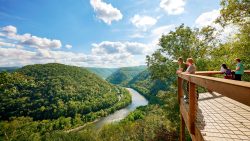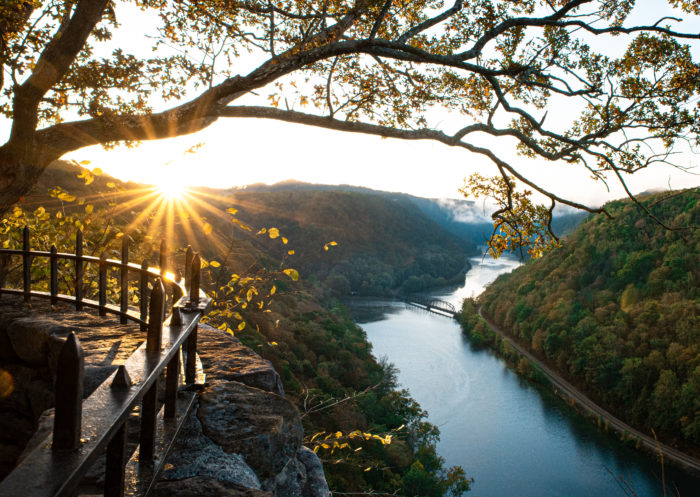9 of the oldest buildings in WV have amazing stories
A state that’s known for literally creating itself during the Civil War is bound to have a storied history. West Virginia’s hills are full of historical gems, tucked into valleys and plopped atop ridges.
Discover the history behind 9 of the state’s oldest structures:
1. Trans-Allegheny Lunatic Asylum
Construction of the Trans-Allegheny Lunatic Asylum in Weston began in 1858. The onset of the Civil War left the asylum incomplete until the 1880s. The building features intricate stone work— with many hidden faces in its facade— and is still the largest hand-cut stone masonry building in North America.
The asylum was designed following the “Kirkbride Plan.” Dr. Thomas Story Kirkbride believed hospitals for the mentally ill should be placed on sprawling and ornamented rural property and arranged so that patients received a generous amount of therapeutic sunlight and fresh air. Kirkbride inspired more than 300 similar buildings, palace-like sanctuaries for the insane, of which he called “a special apparatus for lunacy.”
Patients could be admitted to the hospital for any number of reasons, ranging from “death of sons in war” to “women trouble” to “snuff eating.” The hospital reached its peak occupancy in the 1950s with more than 2,400 patients. The facility closed in 1994, but is still open for tours year-round.
2. Governor’s Mansion
For the first 30 years of West Virginia’s statehood, there was no Governor’s Mansion. In 1893, Governor Aretas Fleming suggested that funds be appropriated for a state-owned mansion, and $22,000 was provided for the next governor, William MacCorkle, to buy and furnish an elaborate residence across from the then-State Capitol on Capitol Street (which burned down in 1921).
After the fire, funds were allotted for a new Capitol, including $100,000 for a new Governor’s Mansion. Governor Ephraim Morgan appointed Charleston architect Walter Martens to design the new mansion, with help from the Capitol’s architect, Cass Gilbert (they wanted the 2 structures designed in similar fashion). It was completed in 1925.
Governor Morgan was the new home’s first (and very-short lived) resident— he moved in just one week before his term ended. The state still uses this 30-room, red brick executive mansion to house the governor. The first floor includes a ballroom, library and drawing room, and is used for entertaining and official meetings.
3. Blennerhassett Mansion
A very wealthy Irish couple, Margaret and Harman Blennerhassett, emigrated to America and settled on a secluded, wooded island on the Ohio River in 1798. They built a showy 7,000-square-foot Palladian-style mansion, complete with extravagant furnishings from abroad, silver hardware and decadent, sprawling flower gardens. At the time, it was one of the United States’ largest homes.
Only a few years after the lavish home was erected, the couple became involved in a mysterious military enterprise with politician Aaron Burr. President Thomas Jefferson accused them of treason, and they fled their island utopia only hours before the military invaded. Blennerhassett and Burr were thrown in the Virginia State Penitentiary. They were later released, but their reputations were ruined. Blennerhassett purchased a small cotton plantation and moved his family to Mississippi.
The mansion burned to the ground in 1811, and archaeologists rediscovered the home’s foundations in 1973. It was carefully reconstructed from 1984 through 1991 and is now a centerpiece for the Blennerhassett Island Historical State Park.
4. Morgan’s Kitchen
In 1846, John Morgan Jr. built a tiny log cabin which served as a kitchen house for the family’s 600-acre estate in Putnam County. In those days, the kitchen was often built separate from the home to moderate heat in the summertime and protect the main living quarters from fires.
During the Battle of Scary Creek in July of 1861, Union troops camped on the Morgan estate and were fed from this tiny personal kitchen. The small log structure also served as a hospital to wounded soldiers.
The kitchen’s original location was on Morgan’s plantation near the present John Amos Electric Power Plant. The kitchen was moved to St. Albans by his son, Sid Morgan, in 1972, partially to save it from destruction. The St. Albans Historical Society was formed that year and still maintains the cabin. They conduct open houses every Sunday in the summer, where guests can get a peek of Civil War-era living, including period cookware, rustic furnishings and the black charred ceiling that still remains.
5. Berkeley Castle
If it weren’t for love, Berkeley Springs wouldn’t be home to a gorgeous and unusual castle. The Berkeley Castle was built between 1885 and 1891 by a wealthy businessman named Colonel Samuel Taylor Suit and is thought to be the only Norman castle in the U.S.
At 46, Suit fell in love with the daughter of an Alabama congressman, 17-year-old Rose Pelham. It took many years to persuade the young woman to marry him. Successfully winning her hand in marriage took a promise to build her a castle in the town of Bath (also known as Berkeley Springs), which is known for its natural mineral water spas.
It took about 100 German masons to create the 20-room castle, carrying hand-cut stones to the site by horse and wagon. Suit died in 1888— before the 6-year project was finished— leaving in his will a mandate that Rosa finish the castle in order to inherit his fortune. The widow hosted lavish parties there into the early 1900s, when she ran out of money and the castle was sold at public auction.
Berkeley Castle is now a private residence and no longer open for tours, though it is available for weddings and other private and corporate events.
6. Bramwell’s Isaac T. Mann house
In the late 1800s and early 1900s, Bramwell was home to the highest number of millionaires per capita in the country.
The streets of Bramwell are packed with well-preserved historic homes. Among those is the Isaac T. Mann house, built by Mann and his wife, Vernie Myers. The 3-story home overlooking the Bluestone River contains an intricate staircase, beautiful woodwork, secret safes and a leather-walled den. Across the river and accessible by footbridge, he built a “playhouse” (a full-sized house) for his children.
Mann was one of Bramwell’s most colorful residents. He was president of the Pocahontas Fuel Company, a banker and real estate mogul, among many other things. In 1928, he was even offered the position of ambassador to Spain by President Coolidge. Ever heard of the West Virginia town named Itmann? That was originally a 120-dwelling colony built by Mann to house Pocahontas Fuel Company employees.
As you stroll down the brick-cobbled Millionaire Row, keep in mind that friendly homeowners are known to invite bypassers in for a closer look and a crash history lesson.
7. The Greenbrier
The Greenbrier Resort has been a getaway for guests from around the world since 1778, including 26 presidents and countless celebrities. It was built on a spring of sulphur water that drew many to the resort for its curative properties.
It has changed hands and names several times, though Chesapeake & Ohio Railway (later known as CSX Corporation) owned the swanky resort for most of its history. During the Civil War, both sides occupied the resort as a hospital or headquarters. During WWII, The U.S. Army converted the hotel into a 2,000 bed hospital known as Ashford General Hospital.
Guests can take a historic tour of the top-secret, super-sized bunker built under the resort for all 535 members of Congress during the Eisenhower era. The bunker was stocked for 30 years but never actually used as an emergency location. Its existence was not public knowledge until 1992, when The Washington Post revealed it. After the story, the government decommissioned the bunker.
8. Harper’s Ferry Armory
The Harpers Ferry Historic District contains about 100 historic structures between 2 tiny 19th century villages bordered by the Potomac and Shenandoah Rivers. Many houses built by the U.S. Government to accompany the Harper’s Ferry Armory still stand today.
The armory at Harpers Ferry was the second-ever national armory, with construction beginning in 1799. The small 1-room building produced muskets, rifles and pistols using machinery powered by the river. By the late 1850s, the armory was renovated and expanded— going from a workforce of 25 to about 400. 7 new workshops were added, and these buildings became known as the “U.S. Musket Factory.” It is most famous for being seized by abolitionist John Brown.
The Civil War brought destruction to the armory. Confederate troops seized much of their contents and burned the remaining armory buildings to the ground. Today, only the fire engine and guard house (known as John Brown’s Fort) remains. Because the fort’s original site was covered with a railroad embankment in 1894, the building now sits about 150 feet east of its original location.
9. Bottle & Wedge
A tiny specialty beer and cheese shop in Huntington holds a whole lot of history. Bottle & Wedge is housed in the original location of the Bank of Huntington, which is said to have been robbed by the infamous Jesse James and a crew of 3 others in September of 1875. The crew made out with $20,000 stuffed in sacks, and then shot up and down Third Avenue in true “wild West” fashion.
The cashier station at Bottle and Wedge sits shielded by the original teller window. There’s still some debate about whether or not Jesse James was actually there. Regardless, the building has a storied past. The Bank of Huntington was founded in 1872 and became what is known today as the First Huntington National Bank.
How many of these historic buildings have you visited?
This post was last updated on July 21, 2020








